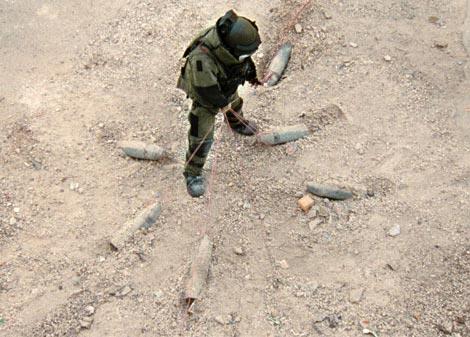Major Jennifer Grieves made history last week. She was the first
female to pilot Marine One—the helicopter that flies President
Obama. During her interviews she said; “Obviously, meeting the
President of the United States is an exceptional opportunity … but
I think just being a Marine is far above that privilege.” Later on,
she added, “but I would have to say I’d do it for free.”
And although being the President’s helicopter pilot is a job
many would be willing to do “for free,” how many of us would
volunteer for the job of disarming booby-trapped bombs in Iraq?
In the amazingly visceral new movie The Hurt Locker,
Sergeant William James (Jeremy Renner) volunteers, not just once,
but over and over again. “How many bombs have you disarmed?” an
impressed colonel (David Morse) asks Renner after he takes care of
a massive car bomb in front of the UN compound. “Eight hundred and
seventy three,” Renner answers, “counting those in the car
today.”
But unlike Major Grieves, Renner is no gung-ho soldier immersed
in esprit de corps. A newcomer to this particular three-man
Explosive Ordinance Disposal (EOD) unit, the old-timers Sergeant
Sanborn (Anthony Mackie) and Specialist Eldridge (Brian Geherty),
don’t much care for how Renner repeatedly ignores safety procedures
and puts himself, and them, directly into harm’s way. “He’s going
to get us killed,” Eldridge says to Sanborn, a few weeks later,
when Renner returns to a bomb-disposal site to retrieve his
forgotten gloves. Sanborn holds up the bomb’s remote control
detonator and conspiratorially says to Eldridge, “Accidents happen
all the time.” And the way the movie has been set up, we can
understand why the two men might agree to push the button and
eradicate this continual threat to their life and limb.
The power of this movie is its constant level of uncertainty.
Because James Bond and the Mission Impossible team have always
managed to clip the correct colored wire with just a few seconds
left on the digital clock, we have previously been lulled into a
passive set of expectations when it comes to defusing bombs in
movies. But director Kathryn Bigelow and screenwriter Mark Boal
know those artificial rules don’t apply in Iraq and Afghanistan,
and they purposefully keep us on the edge of our seats.
Filmed in the slums and desert near Amman, Jordan, Bigelow and
her cinematographer Barry Ackroyd have created a palpable reality.
We can feel the scorching heat, taste the grit in our mouths and
smell the decay and blood and burning petrol and cordite that
infuse the atmosphere. Because this film is so artfully constructed
(and an almost sure contender for next year’s Oscar), we even
manage to know more than what is seen onscreen. For example, we
know why as soon as Renner returns to base after one eventful
mission, he enters the shower in full armor to let the hot water
wash away as much as it can. We know why the team members bond one
evening by taking turns slamming their fists into each other’s
bellies. We know why Eldridge will never forgive Renner for one
particular, gung-ho mission. We know why a foil packet of fruit
juice has never tasted better.
And most important of all, The Hurt Locker gives us a
glimpse into why some chosen few volunteer to put on a Kevlar blast
suit and methodically grapple with an explosive device specifically
constructed to render them into miniature droplets of gore. It is
not just because this is a way that they can be soldiers whose main
mission is to save lives, not take them. Nor is it because they
have a death wish or feel the need to play chess with the Grim
Reaper. What you will discover in this adrenaline-powered movie is
that Renner’s motivation is much simpler, but I won’t spoil it for
you. That secret is something for you to learn for yourself.
Comments? Email Gil at: gi*********@*****st.net.









